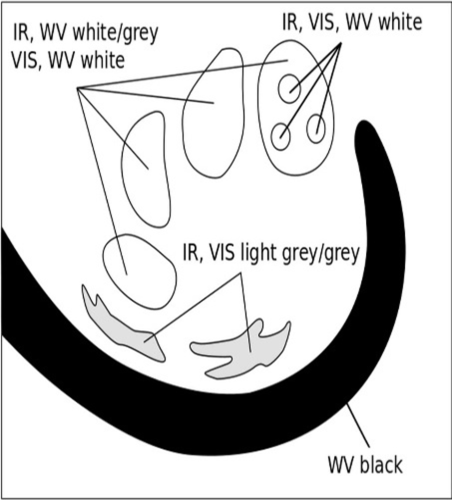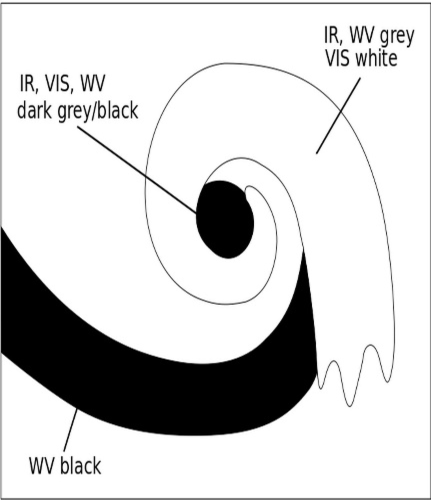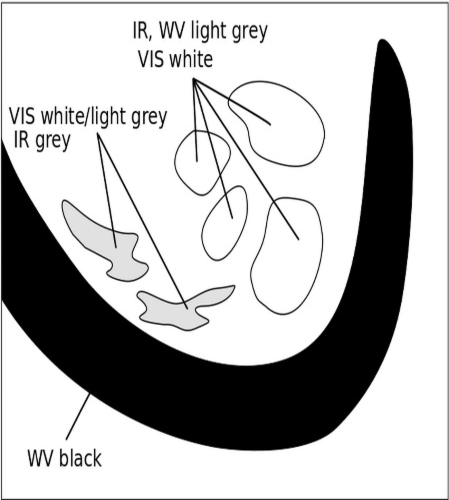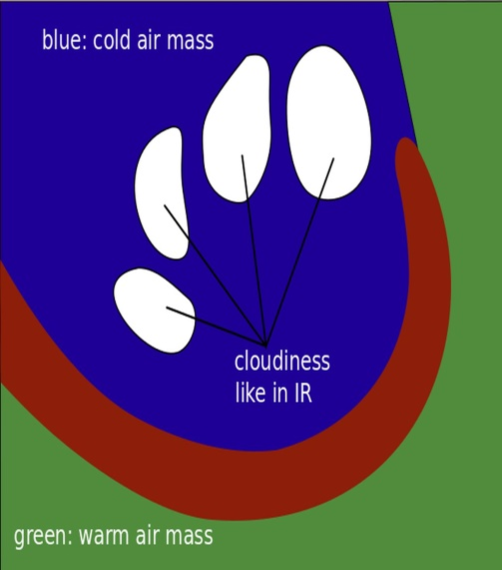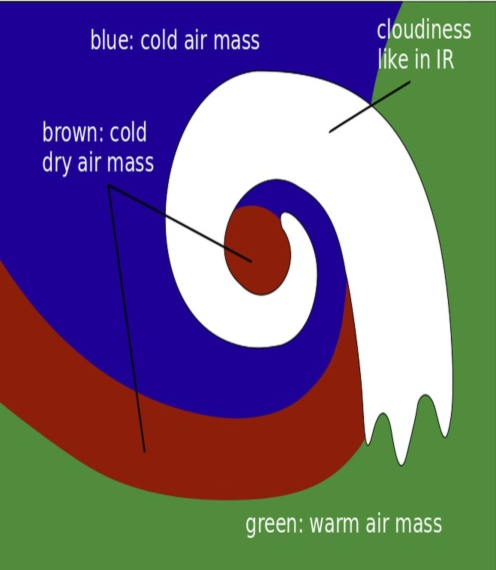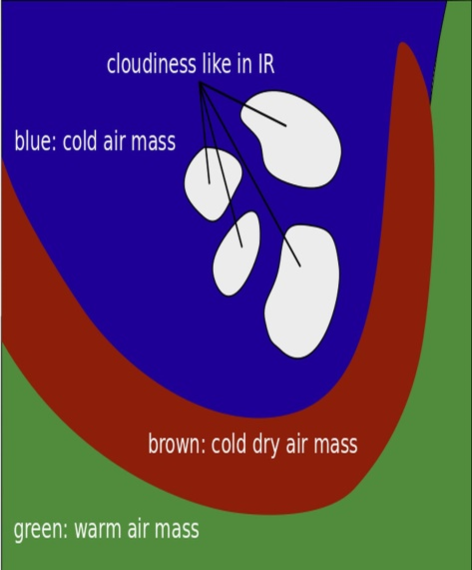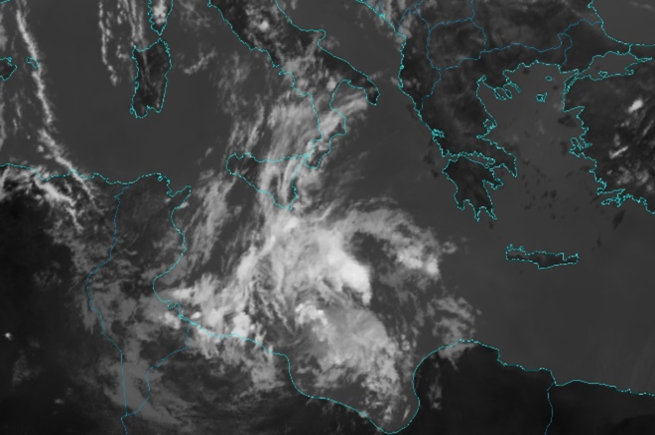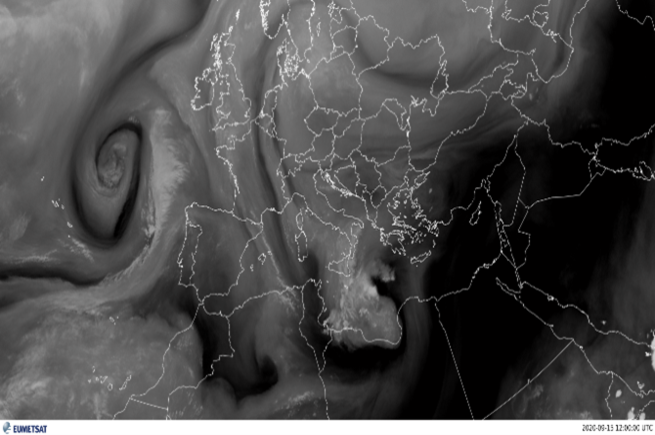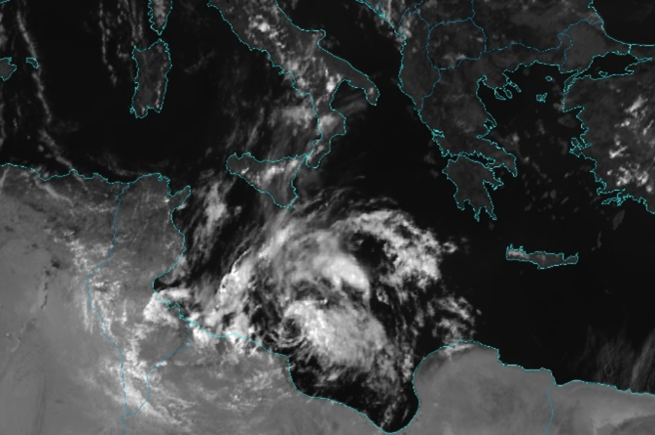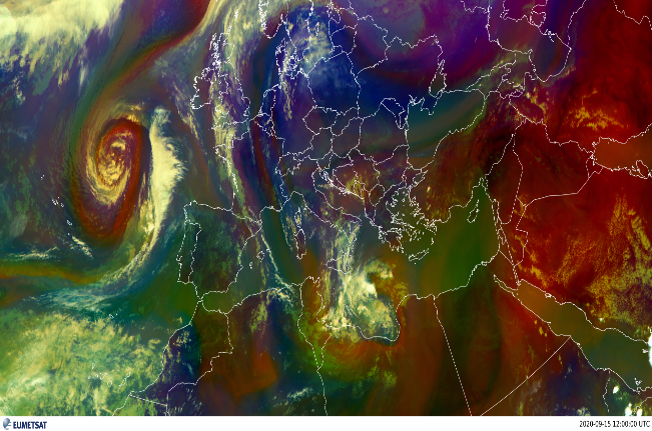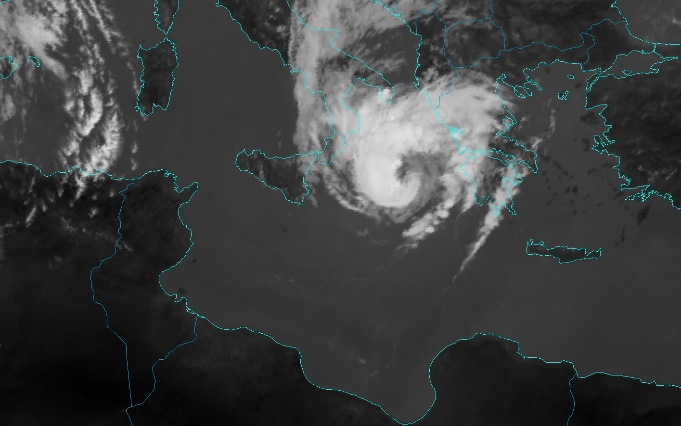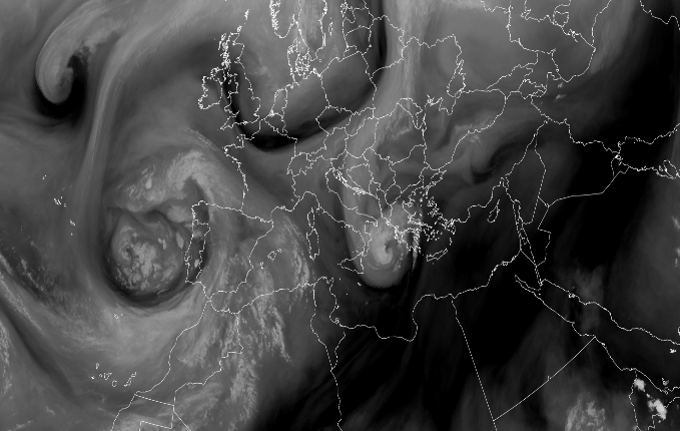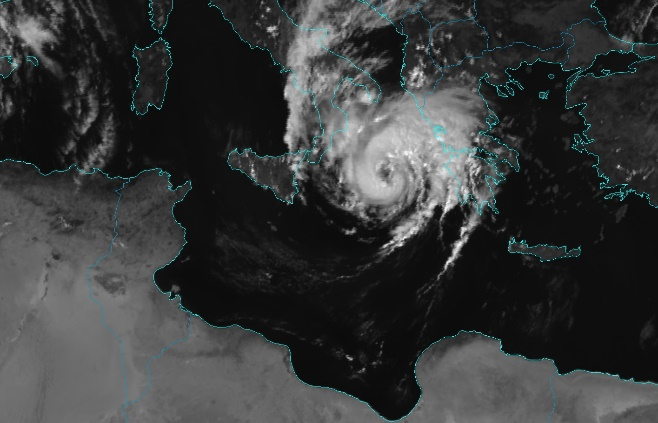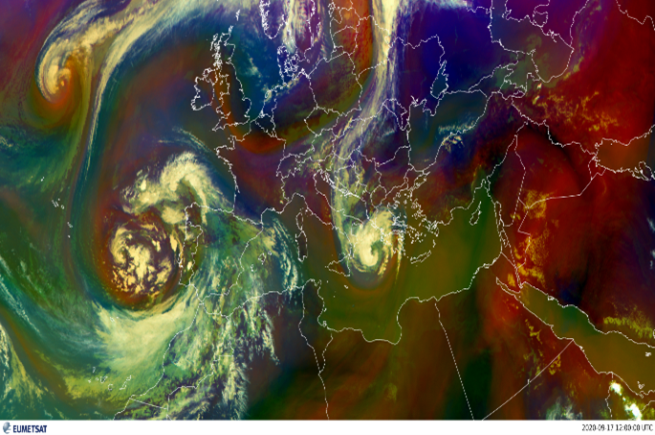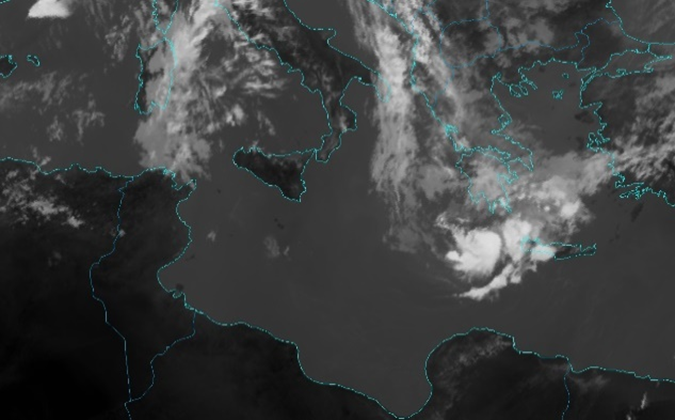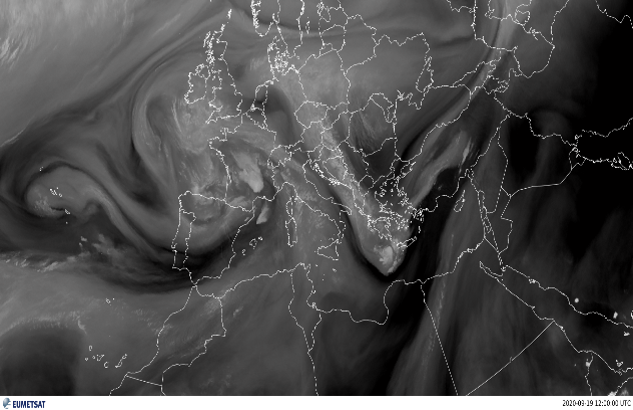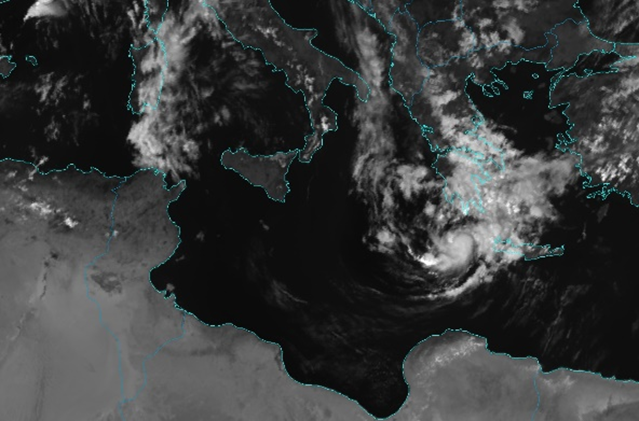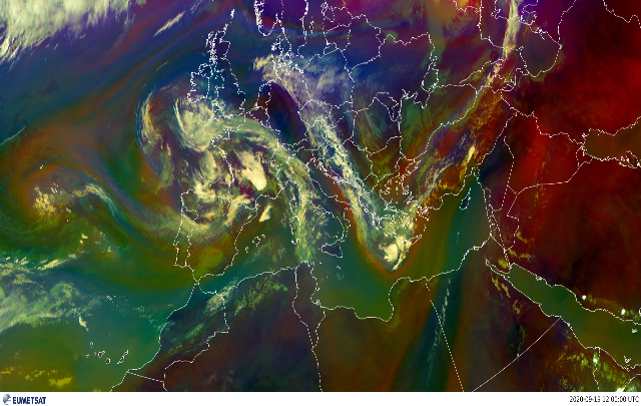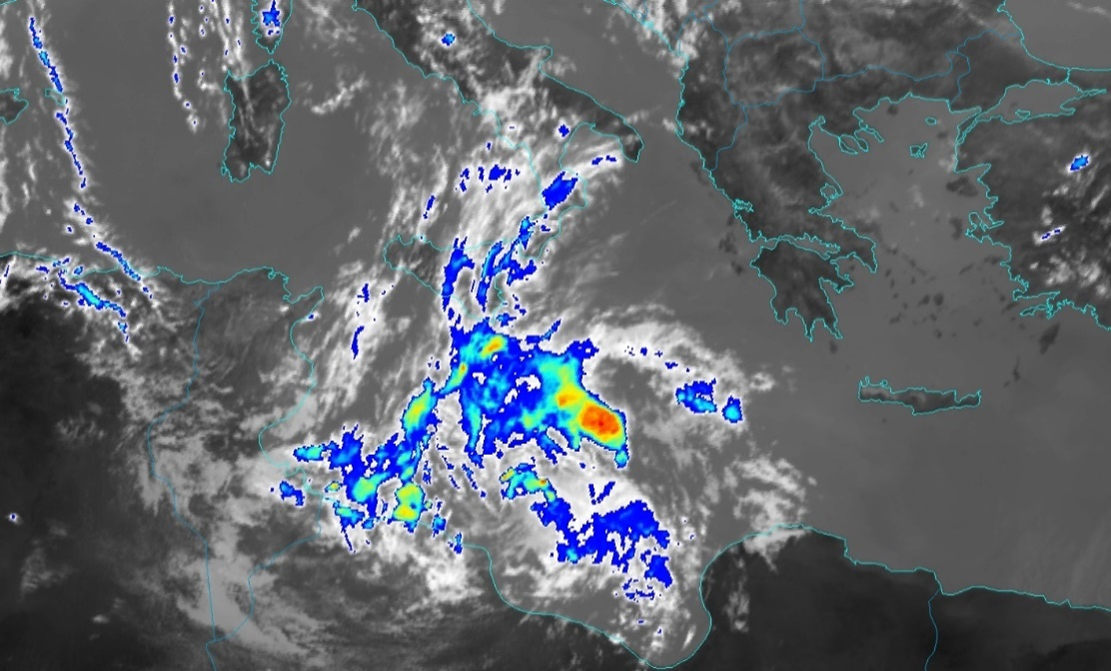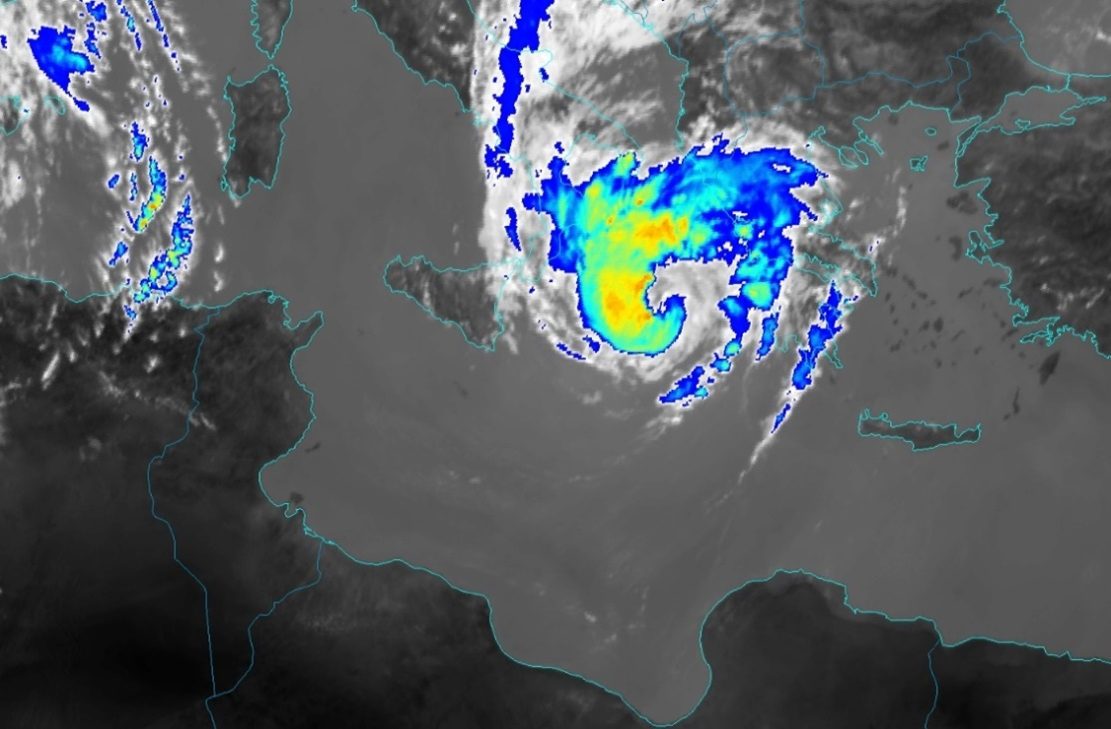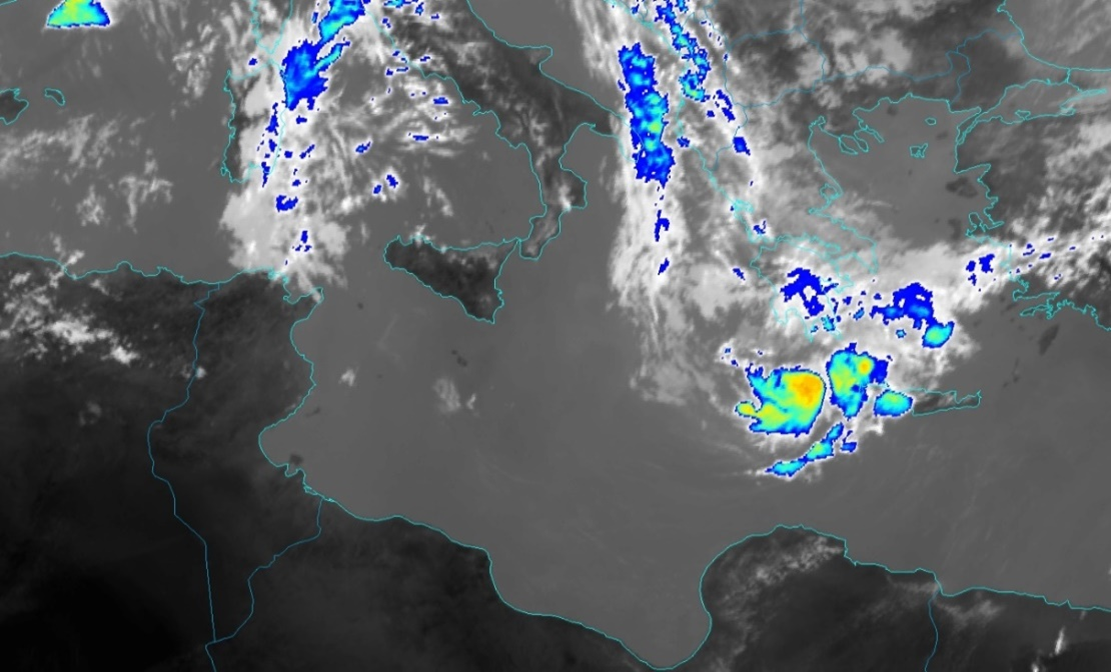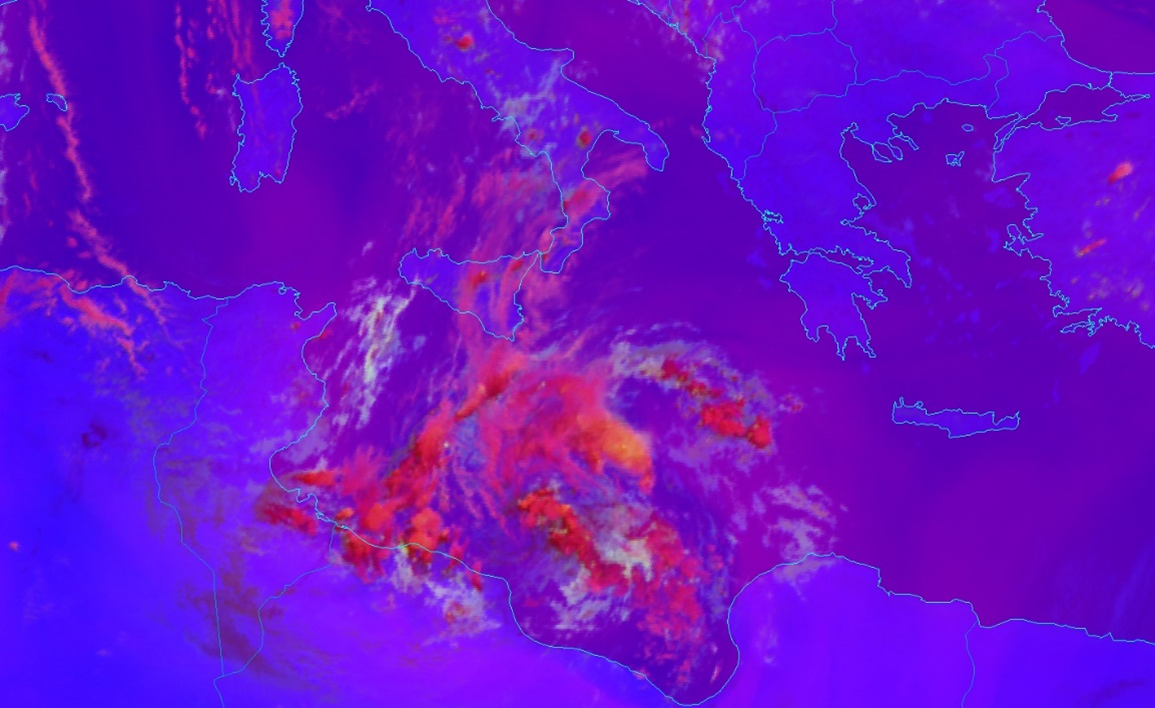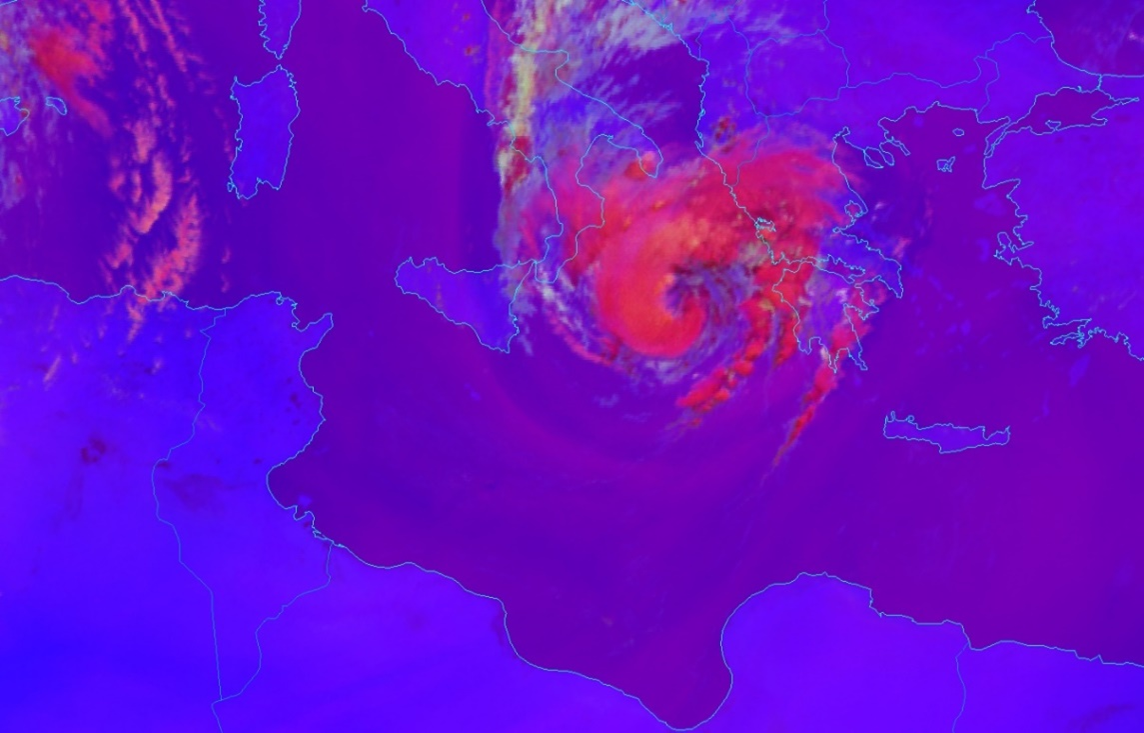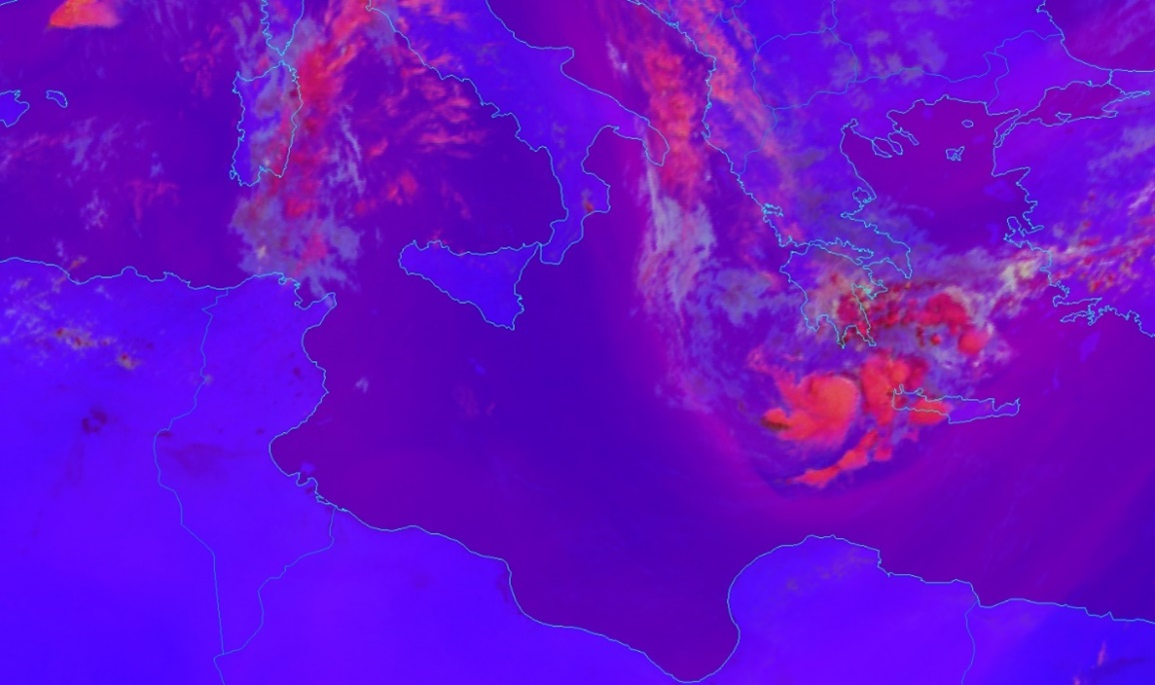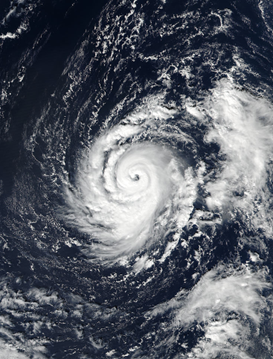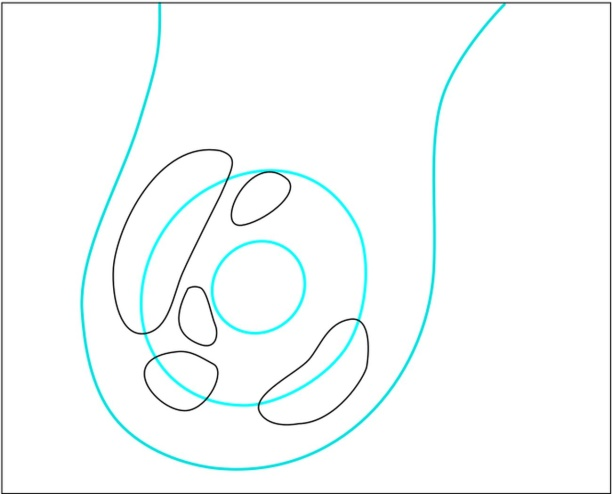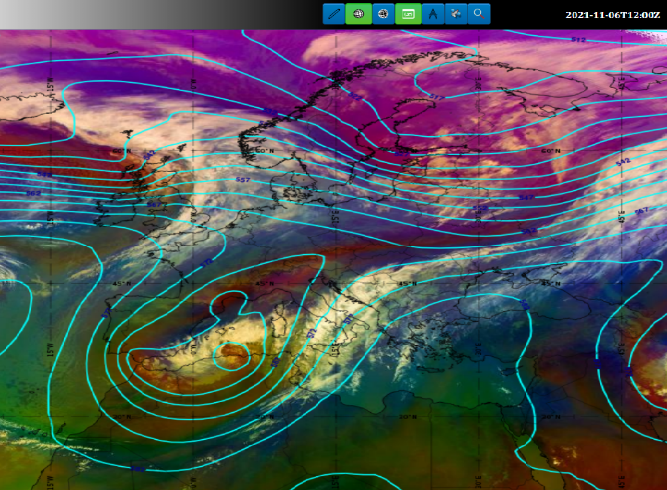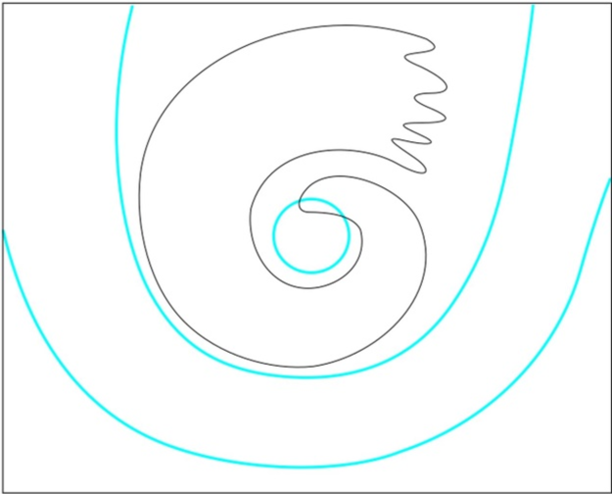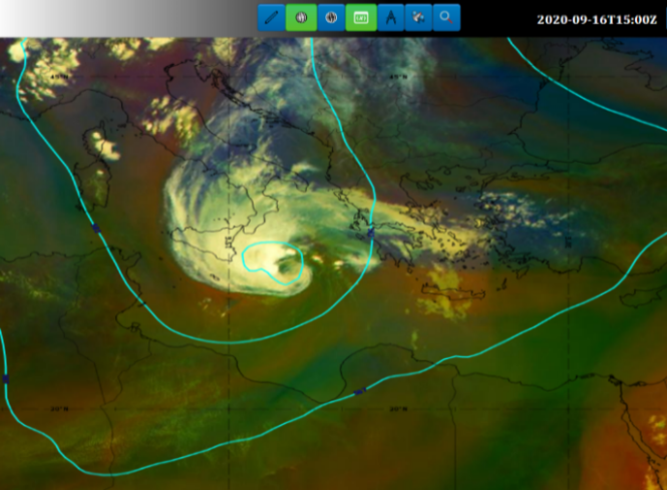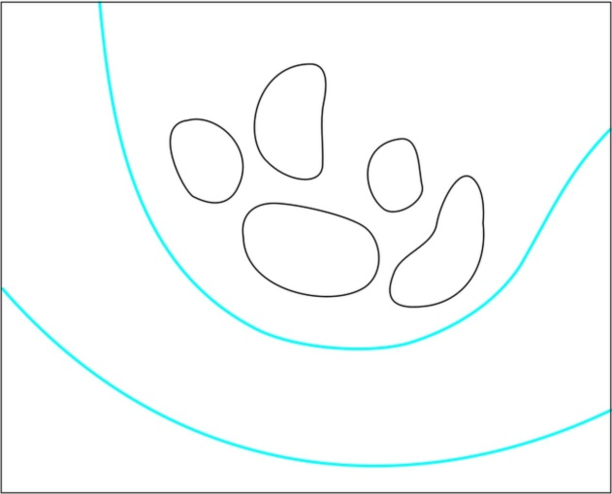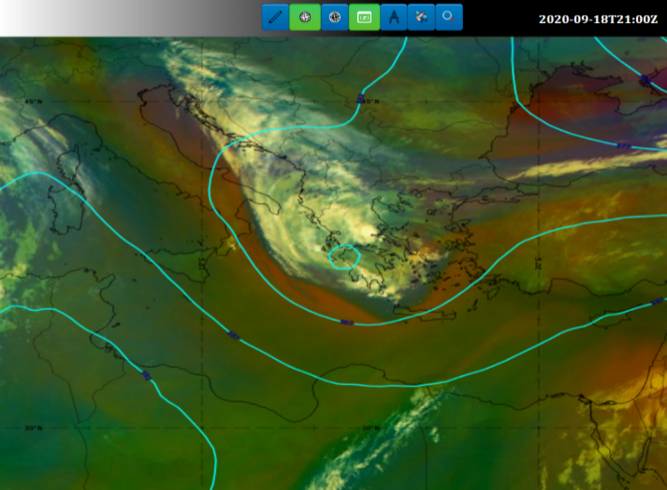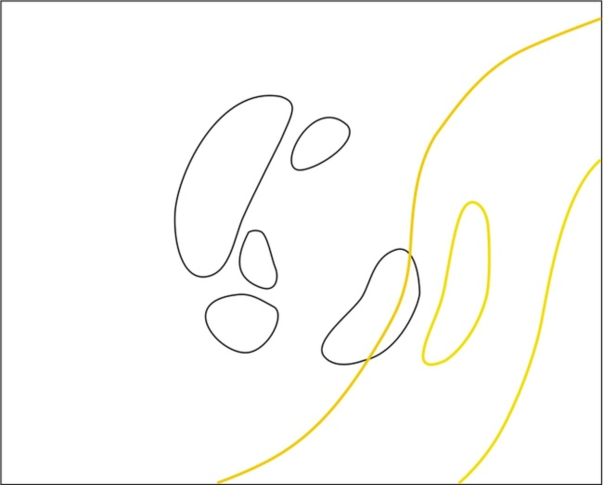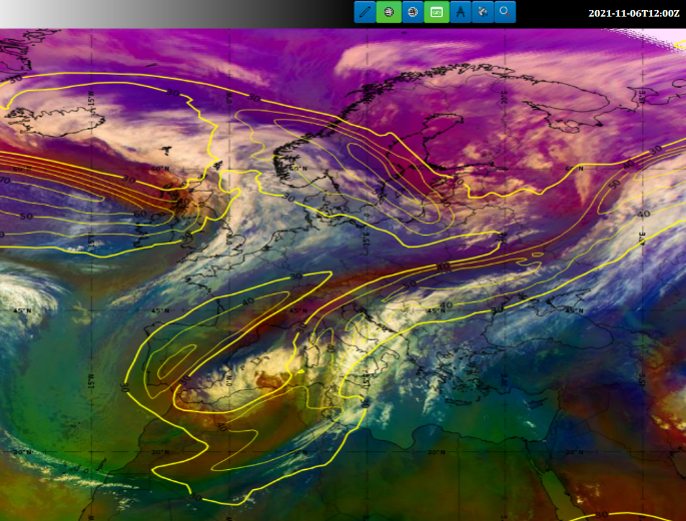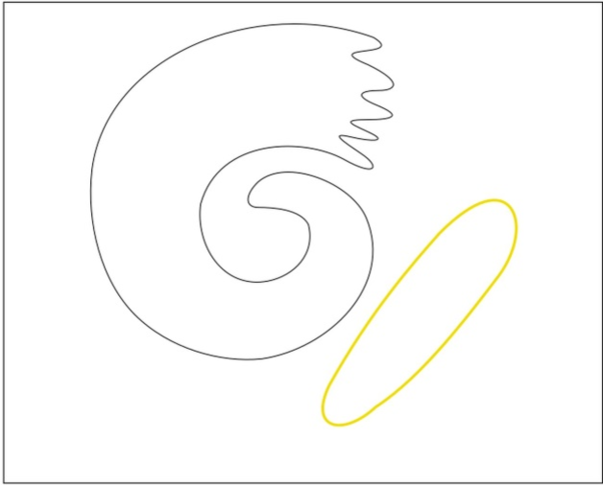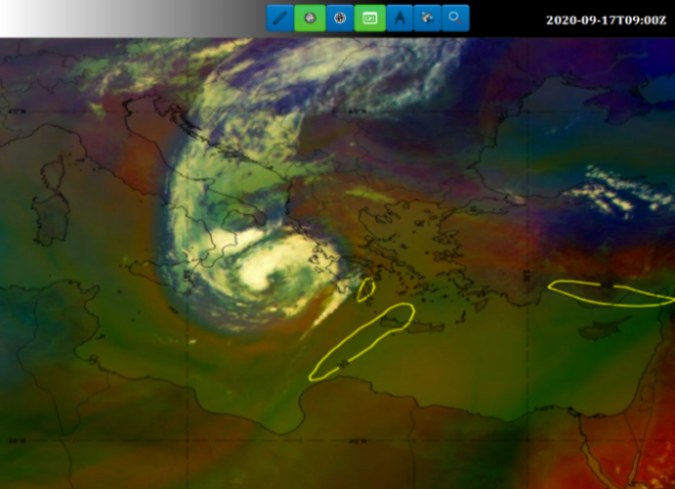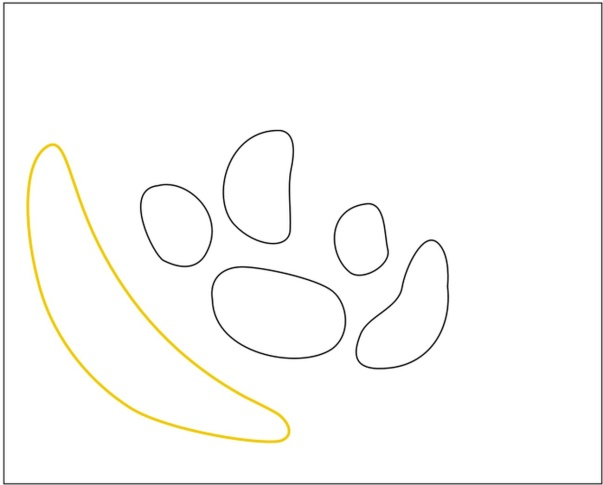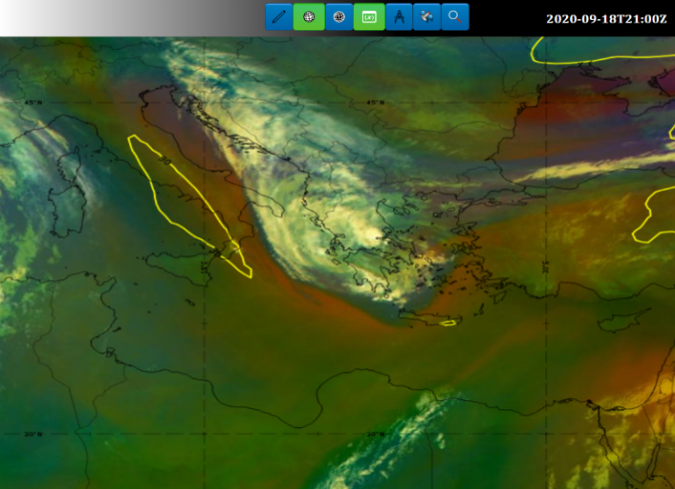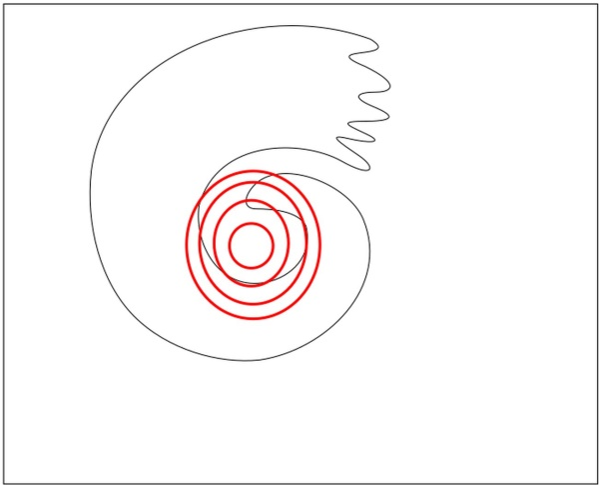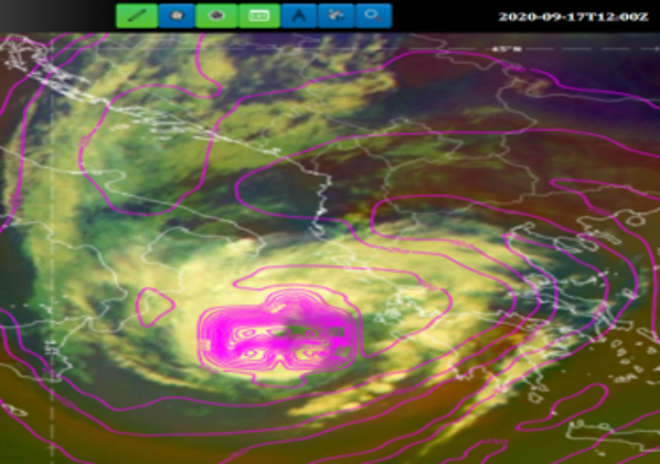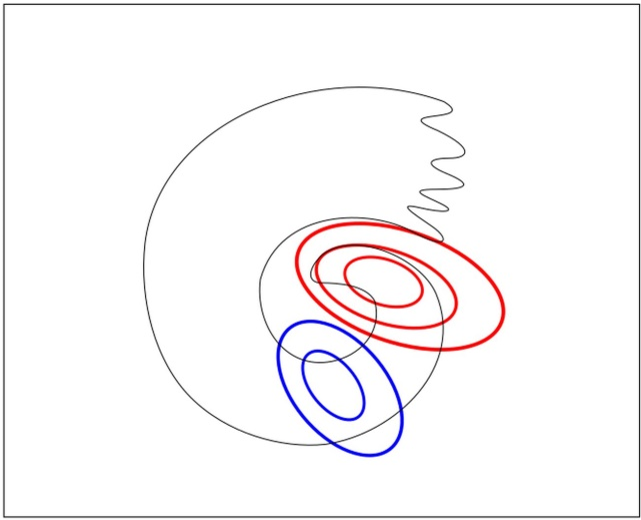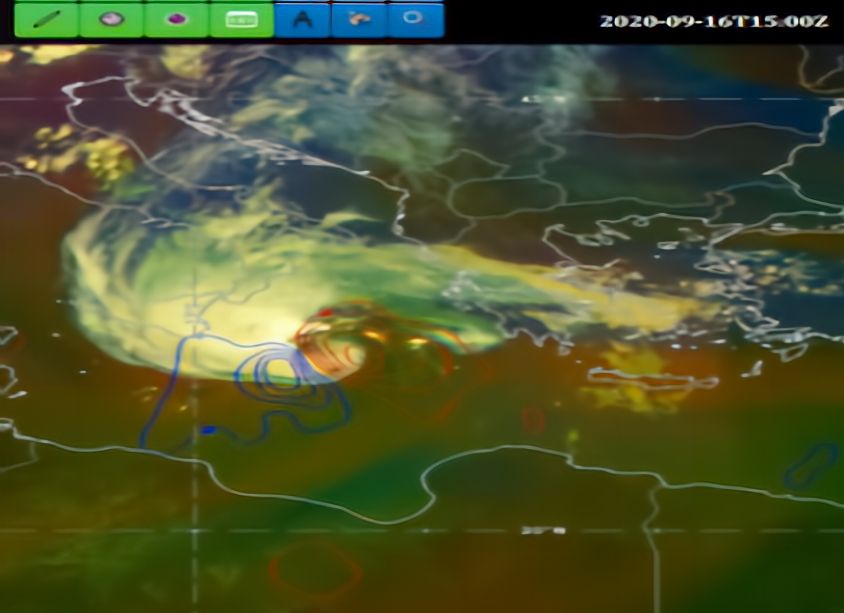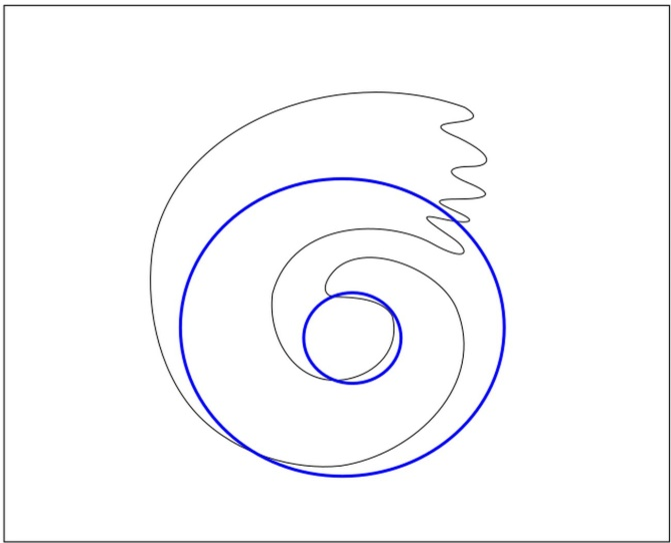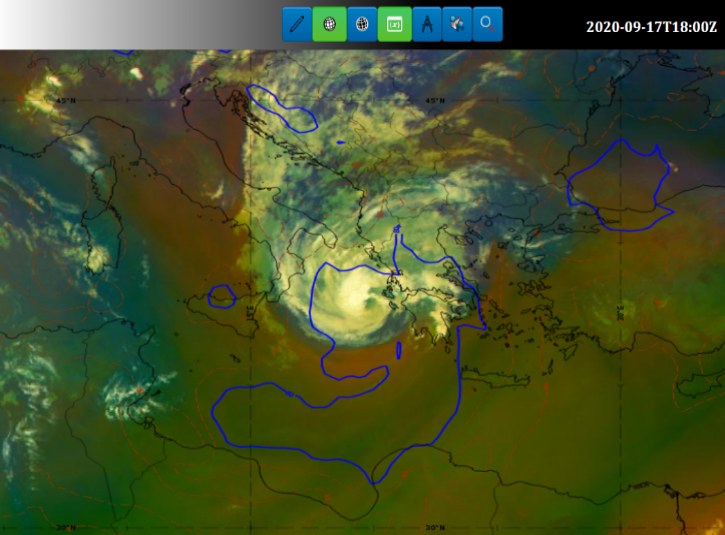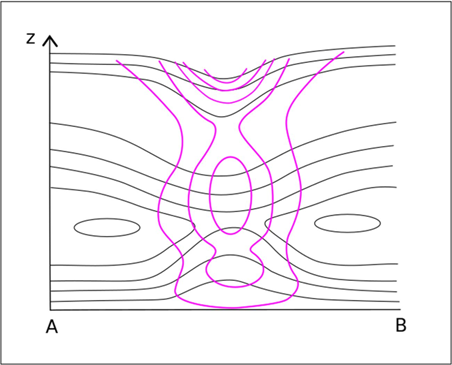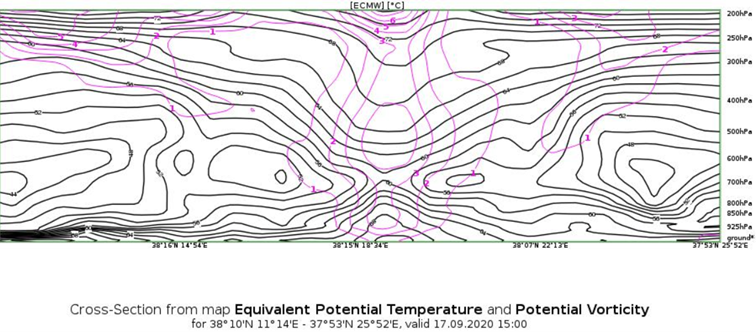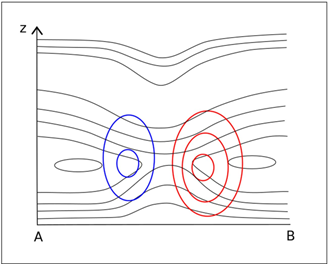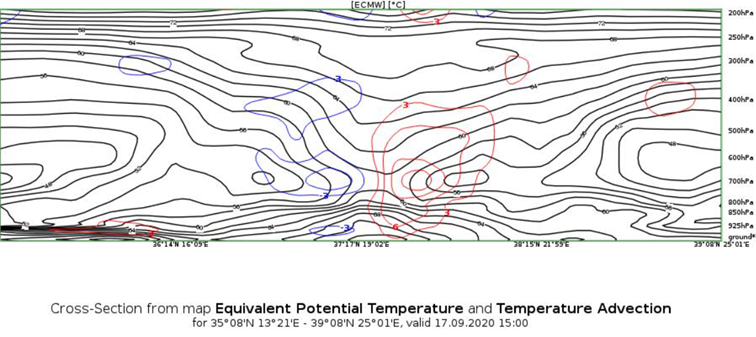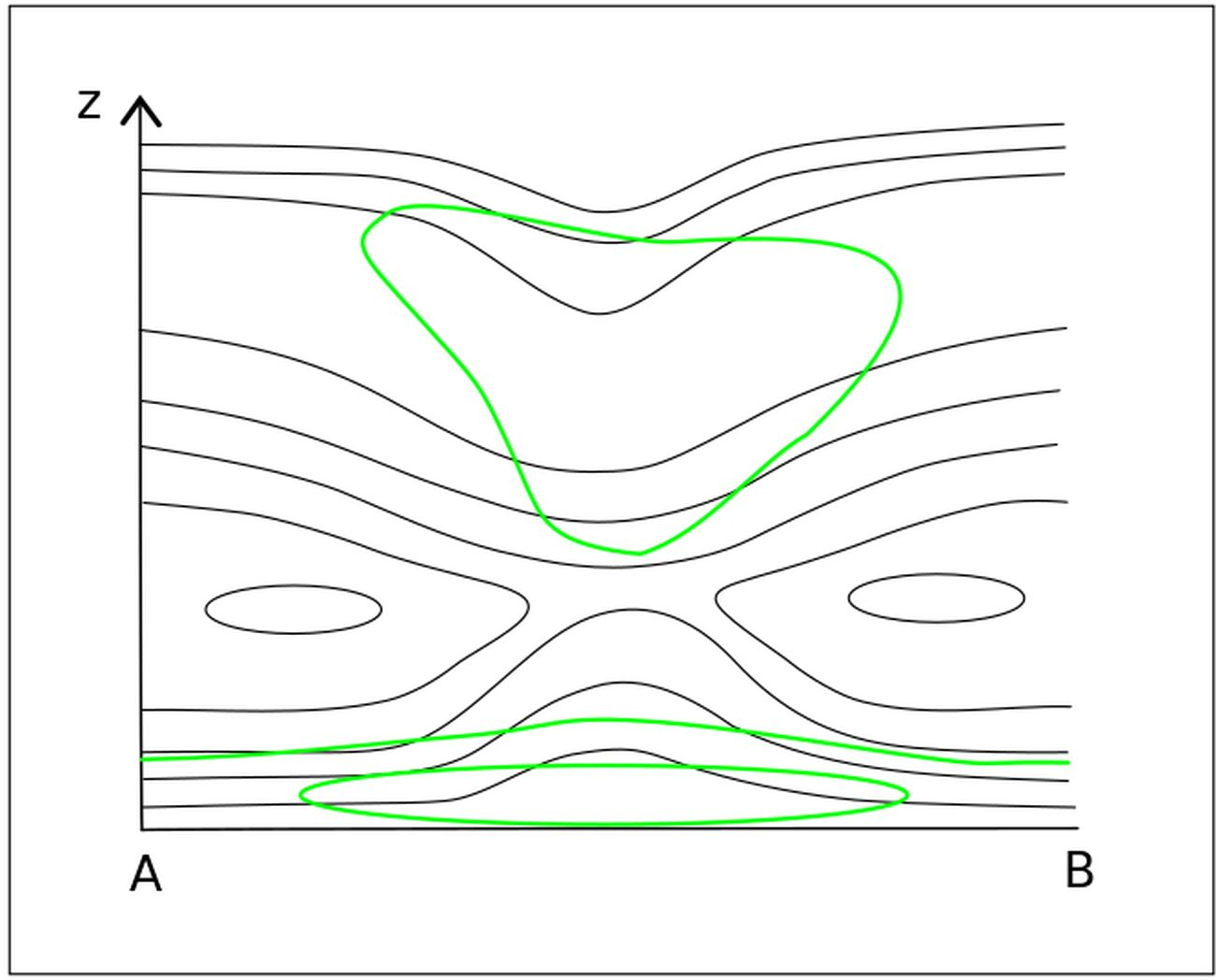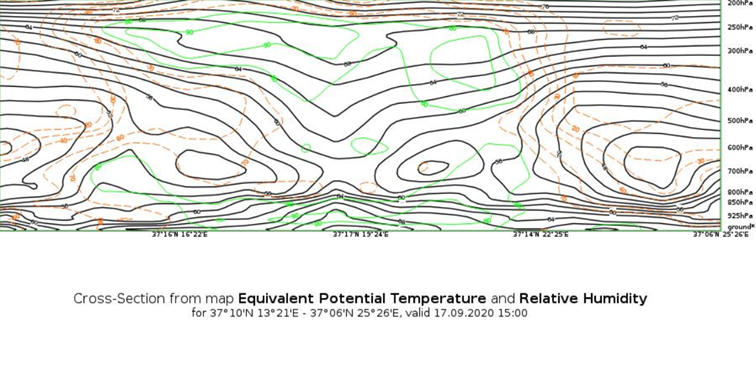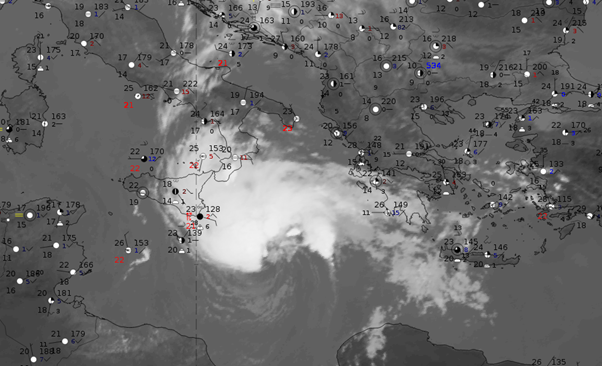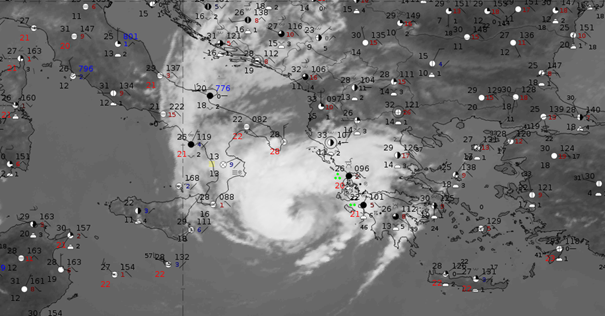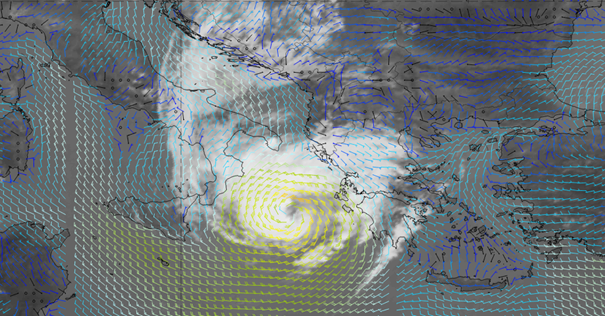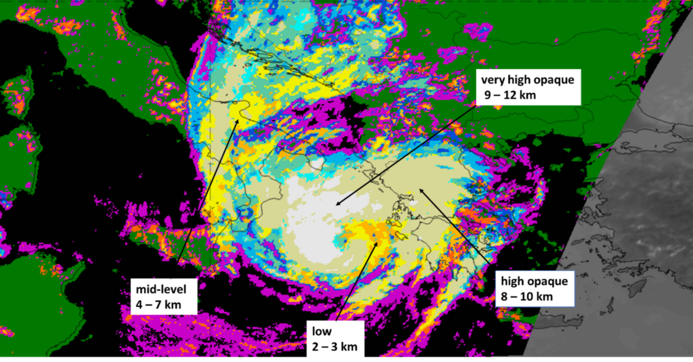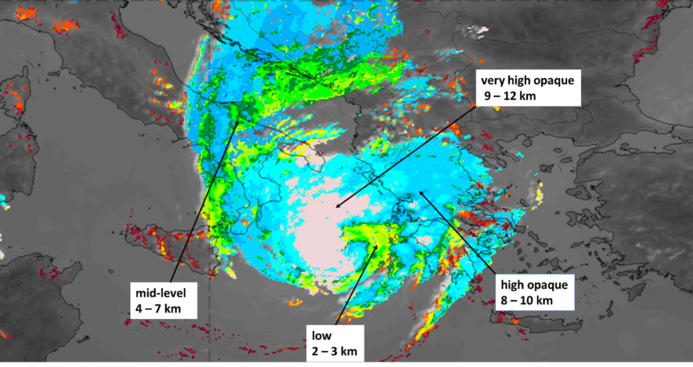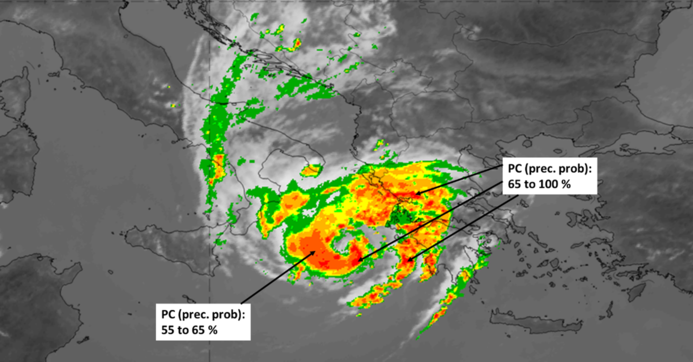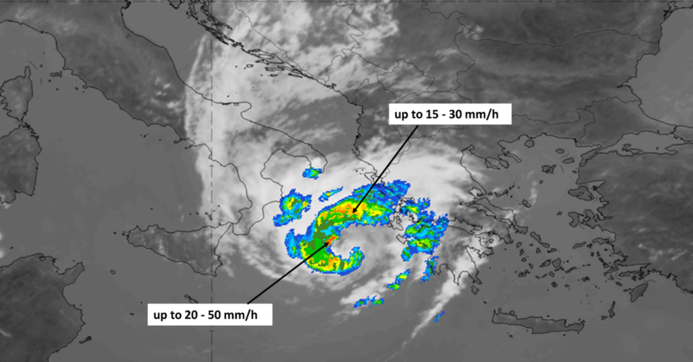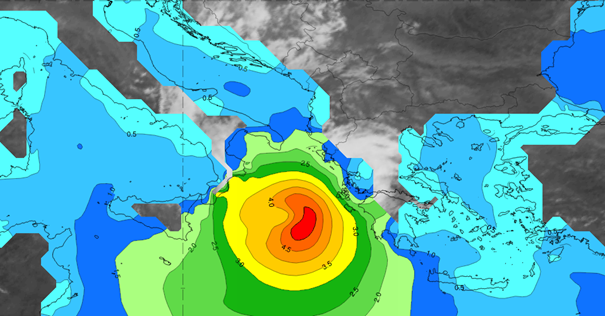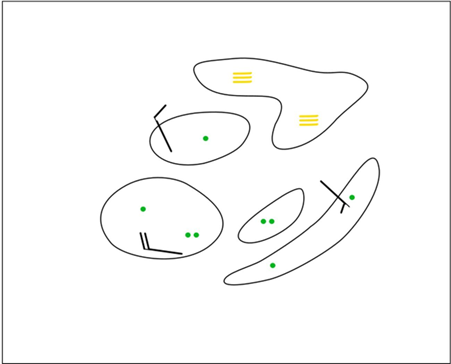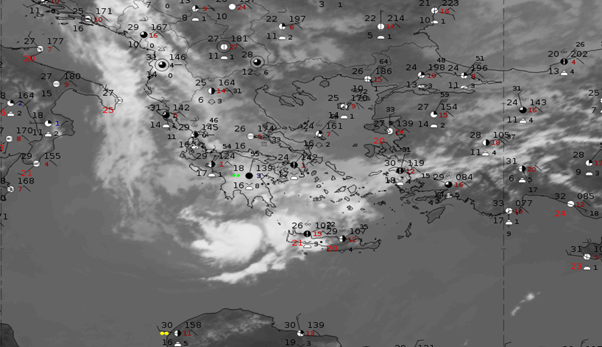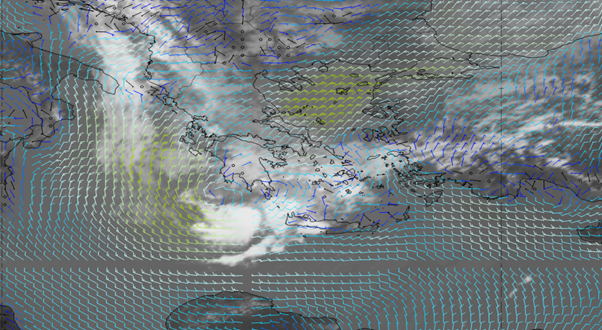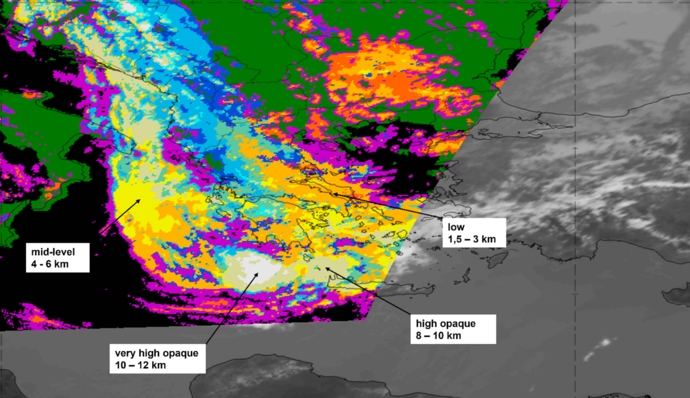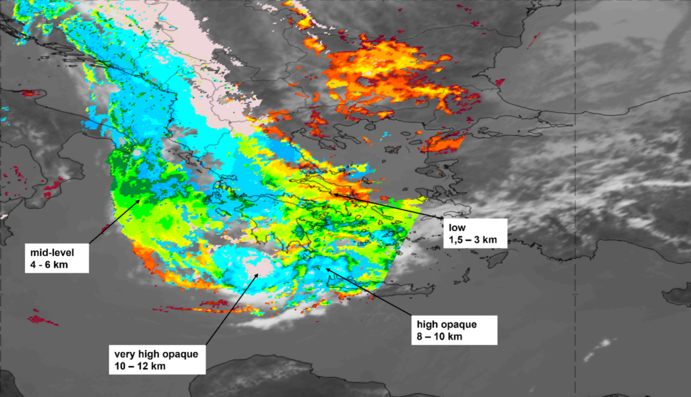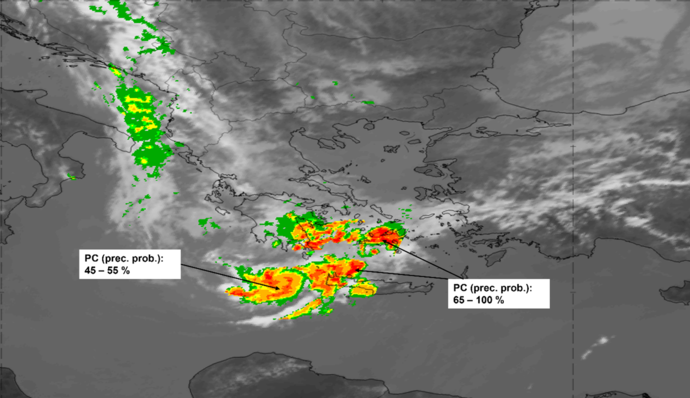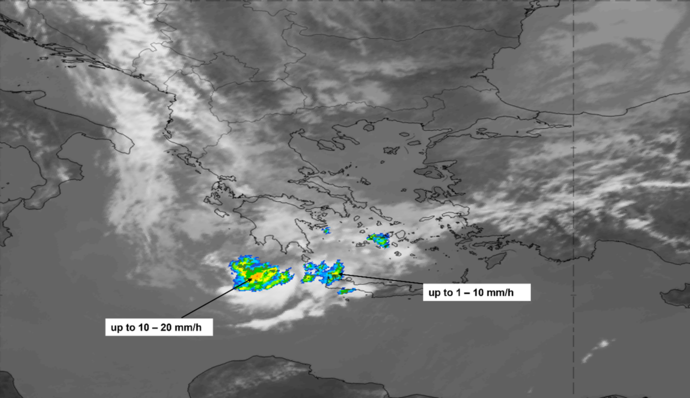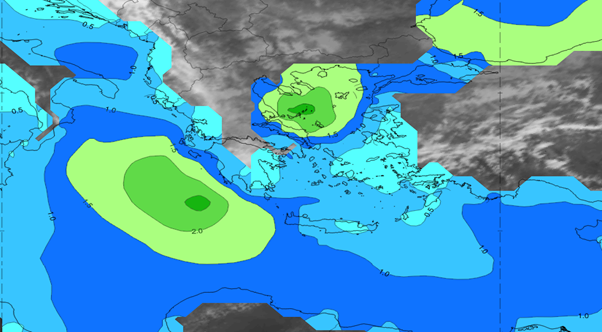Table of Contents
Cloud Structure In Satellite Images
Medicanes (from MEDIterranean hurriCANES) are rare (~ 1-2 per year) intense and destructive warm-core cyclones occasionally generated in Mediterranean Basin.
Medicanes appear in three stages. Stage one, or the formation stage, is characterized by rapid intensification of the system and occurs before the formation of a clear eye. In the mature stage the system develops clear cyclonic rotation and a circular eye. The final, decay stage is when the storm loses its strength and structure.
Appearance in the basic channels
When viewed in visible (VIS), infrared (IR) and water vapor (WV) images, we can see that medicanes show several common features on all three channels throughout the three stages (Figure 1).
- In the formation stage CB clusters are generally white in VIS, IR and WV images, which is an indication of clouds that are cold and thick and spread through the whole troposphere. Some lower clouds in IR and WV imagery are grey.
WV6.2 imagery
- One of the most important parameters for medicane development is the atmosphere's water content. It can be observed with the WV6.2 channel, which shows water vapor in the higher layers of the troposphere in shades of grey. The brighter the colors are, the more water vapor is contained within the air. Bright areas show convective development. The dark areas are dry stratospheric air, which is often engaged in the development of a medicane. Dry intrusions are an important mid-latitude atmospheric phenomenon within the upper troposphere and lower stratosphere. It is often found to be related to cyclogenesis, rainstorms, as well as convection generation and precipitation enhancement.
VIS0.6 imagery
- In VIS images even some thicker lower clouds appear white, making these channels the best choice to identify the location of the eye, due to the clear contrast between clouds and the surface.
IR10.8 imagery
- In IR images the grey shades can vary between grey and white. Since it is sensitive to high cirrus clouds with low temperatures, and is good in differentiating lower and higher clouds, it is better than VIS channels for showing the beginning of cyclonic curvature in the convective cloudiness.
Figure 1: Schematics of the development stages of a medicane as depicted in the SEVIRI channels IR10.8 µm, WV6.2 µm and HR-VIS.
Appearance in standard RGBs
The RGB that exhibits medicane development the best is the Airmass RGB
In this composite, reddish contours indicate dry, sinking, cold, stratospheric air, and show areas with high potential vorticity. Since high PV values are crucial in the generation of vorticity in cyclogenesis, a PV intrusion feeds cyclonic development and the further evolution of the medicane.
In all three stages the presence of a reddish stripe along and at the rear of the cloud band can be observed (Figure 2). In the initial stage there is mostly only a stripe extending from northwest to east. During the development of the system a round area appears in the center of a developing cloud spiral. This development makes the acceleration of the cyclogenesis clearly visible. From the advanced to the mature stage, very intensive dark-brown colors fill the whole area within the spiral.
Figure 2: Schematics of the development stages of medicane as depicted in the Airmass RGB.
Formation stage
Figure 3: Formation stage in SEVIRI channels IR 10.8 µm, HR-VIS, WV 6.2 µm and airmass RGB. Medicane Ianos (15.9.2020. 12 UTC.)
Figure 4: Mature stage in SEVIRI channels IR 10.8 µm, HR-VIS, WV 6.2 µm and airmass RGB. Medicane Ianos 17.9.2020. 12 UTC
Figure 5: Decay stage in SEVIRI channels IR 10.8 µm, HR-VIS, WV 6.2 µm and airmass RGB. Medicane Ianos (19.9.2020. 12 UTC)
Airmass RGB
South of the system, there is a warm tropical airmass with low clouds, seen in hues of green, a cold airmass found to the north of the system, indicated by shades of blue, while thick high-level clouds are bright white.
The vortex-like appearance of the clouds, a well-defined central region of low pressure, a clear eye-like feature and spiral bands of thunderstorms are all characteristic of medicanes and clearly observed in the mature stage.
Development of water vapour convection, indicated by bright colors, and the dry intrusion from the south side of the system are clearly visible. Consistent with tropical cyclones, water vapor advection around the cyclone center is a crucial factor for the initiation and continuance of precipitation in the formation stage.
VIS0.6
The ring around the medicane's 'eye' in the mature stage has high reflectivity values. The cloud development is strongest on the southern side, where it reaches heights up to 11 km, and weakest on the southeastern side. There is a clear cloud-free area with a diameter of approximately 50 km.
IR
Thin cirrus clouds forming cyclonic curvature southward of the convection are clearly seen in this channel. The cyclonic curvature of cirrus clouds indicates the presence of a low-pressure system and the potential for storm formation. When the cirrus clouds form in a spiral pattern around a low-pressure center, it is a sign that the system is becoming more organized and may develop into a stronger storm.
Additional information can be gained from considering other important products.
IR10.8 color enhanced
The enhanced IR10.8. channel (Figure 6) is especially useful with convective cloud systems. It uses IR images that show cloud top temperatures, with different colors assigned to specific temperature ranges. In this stage the cloud top temperatures reach -60 °C on several occasions, which is usually related to deep convective clouds and probability of lightning. During the second stage the cloud tops near the center of the cyclone again break the tropopause barrier, which can be seen from the values of the IR brightness temperature differences being negative, or at best barely positive.
Figure 6: Formation, mature and decay stage in the enhanced IR 10.8 µm channel. Medicane Ianos (15., 17., and 19.9.2020. 12 UTC)
Severe storm
Since the formation stage is best characterized by development of strong convective cloudiness and precipitation it is also useful to examine the Severe Storm RGB. Highest convective activity can be seen during the formation stage. At that time Ianos had not yet lost its extratropical characteristics, but was characterized by high convective activity on the western side of the cyclone center which is indicated by bright yellow spots that indicate thick ice cloud with small ice crystals on the top. Convection in the mature stage is, as expected, weaker than previously. It remains strongest on the western side of the medicane.
Figure 7: Formation, mature and decay stage in the severe storm RGB. Medicane Ianos (15., 17., and 19.9.2020. 12 UTC)
Meteorological Physical Background
Medicanes are rare (~ 1-2 per year) intense and destructive warm-core cyclones occasionally generated in Mediterranean Basin.
Because of their resemblance in appearance (Figure 1) and mechanisms of maintenance with hurricanes, those mesoscale storms have been referred to as 'medicanes' (from MEDIterranean hurriCANES). Similar to tropical cyclones, they only form over the sea and decay after landfall.
Figure 1: Medicane Ianos - The Copernicus Sentinel-3 - 17 September 2020 at 8:48 UTC (left) and Hurricane Ophelia (near the Azores) - MODIS satellite image (true colour) 12 October 2017 at 15:30 UTC (right)
The difference is that medicanes are weaker and smaller in size, with diameters under 300 km, while the diameter of a hurricane is larger than 1000 km. Hurricanes move in general from east to west due to easterly winds, while medicanes generally (but not always) move from west to east due to the mid-latitude westerlies.
Medicanes mostly occur in the western Mediterranean and in the region extending from the Ionian Sea to the North African coast. There is strong variability from year to year without any significant trends.
Between 1947 and 2020, 91 tropical-like cyclones (TLC) were recorded over the Mediterranean. An analysis of these records shows that these events mostly take place late in the year, with the highest rates found in September (21 cases), followed by October, December and November (Figure 2). The reason for this is the combination of cold upper air intrusions and sea water that has had time to warm up. Medicanes most commonly impact the Balearic and Aeolian Islands, Sardinia, Sicily, and southern Italy, although large numbers of casualties have also been recorded on the northern coast of Tunisia. In the past few years, storms such as Zorbas (2018) and Ianos (2020) resulted in casualties and significant damage in Greece.
The numbers do not necessarily mean that all occurrences of medicanes have been recorded, especially ones before comprehensive satellite observations. With the development and constant improvement of satellites, the number of clearly identified medicanes has increased from the 1980s onward (Figure 3).
Figure 2: Monthly number of medicanes for the period 1947-2020.
Figure 3: Number of observed storms in the Mediterranean Sea
Despite the growing interest of the scientific community in medicanes, until now there has been no strict consensus on the physical criteria that would qualify a Mediterranean cyclone as one. However, the most important ones, used by most authors, are the following:
- a frontless and axisymmetric structure
- a wind-free 'eye'
- an eyewall with deep convection and spiral cloud bands
- wind speed of at least 17 m/s, lasting at least 6 hours
Medicanes occur only rarely and special conditions have to be met for one to develop.
Upper-level low, 300 hPa jet stream, baroclinic processes, relative humidity.
Medicanes can develop when cold air intrusions move far southward over the Mediterranean. When a medicane forms, synoptic analysis will show the existence of an upper-level low followed by colder air in the middle and upper troposphere. Upper-level lows provide the energy required for intensifying atmospheric convection, while incursions of cold air will induce atmospheric instability.
The upper level low is often accompanied by a 300 hPa jet stream. It contributes to the synoptic forcing and brings dry air from the upper levels. It is one of the most important initiators of a medicane event. However, since medicanes derive only some of their energy from upper level winds - it will be shown later that latent heat release caused by convection is the dominant mechanism in later stages - a jet stream is not as important of a contributor in other stages. It is therefore strongest in the formation stage, while it weakens or even completely disappears in the later stages.
Baroclinic processes are also important mechanisms of formation and intensification. The baroclinic properties of the Mediterranean region, with its high temperature gradients, also provide the necessary instability for the formation of medicanes. In the first stage of their life medicanes are, similarly to ordinary winter storms, baroclinic disturbances which draw their energy from the available potential energy associated with large-scale horizontal temperature gradients.
Additionally, without high relative humidity in the lower and middle troposphere it would not be possible for medicanes to persist. Some authors state that low and middle tropospheric air with low relative humidity is like poison to medicanes.
The ingredients listed so far - cold upper lows accompanied by jet streams in a baroclinic environment with high relative humidity over the Mediterranean - are not uncommon, whereas medicanes are rare phenomena, suggesting that other favorable environmental factors are also necessary for these systems to undergo a transition to tropical-like dynamics.
Warm core, the 'eye' and convection
The main feature that distinguishes medicanes from 'normal' cyclones is the warm core - atmospheric temperatures in the center of the storm and around it are warmer than their surroundings.
In order to explain the meteorological factors that contribute to the formation of warm cores, many studies focused on air-sea interactions and on the consequent diabatic heating. Like hurricanes, medicanes are the result of a thermodynamic imbalance between sea and atmosphere. A warmer sea will supply more energy and release more heat in the upper troposphere, so the higher the sea-surface temperature (SST), the higher the probability of a transition to a warm core and thermodynamic intensification of the medicane. Air parcels lifted in such tropospheric conditions are very warm and moist at the beginning owing to evaporation from the warm sea. These parcels cool as they are lifted through a deep layer of the troposphere through large vertical displacements. In this process relative humidity increases until it reaches saturation and thunderclouds begin to form. However, that process releases latent condensational heat into the surroundings, which further increases relative humidity until saturation, which in turn releases more latent condensational heat. This feedback loop is what keeps the air within the medicane warmer than that at the same altitudes outside the medicane's influence.
The release of latent heat is a crucial factor in the formation of a medicane's warm core, but it is not the only one. As air in thunderstorm updrafts reaches the top of the troposphere, it moves away from the center, creating an area of divergence. In that way the weight of air columns near the center is reduced, which lowers pressure at sea level.
A warm core is not the only feature that distinguishes medicanes from ordinary cyclones.
The eye of a medicane, similar to the eye of a hurricane, is a region of relatively calm and clear weather at the center of the storm. The eye is typically circular or oval-shaped and is surrounded by a ring of towering thunderstorms known as the eyewall.
The development of an eye in a medicane is the result of the storm's circulation pattern. As air flows toward the center of a medicane, it is subject to the Coriolis force, which causes it to rotate counterclockwise in the Mediterranean area. This rotation creates centrifugal force that pushes the air outward, away from the center of the storm.
At the same time, the low pressure in the center of the storm creates a pressure gradient force that pulls the air inward, towards the center of the storm. These forces, along with the centrifugal force, are in balance, which causes the air to circulate in a circular pattern around the eye.
However, in the eye of the storm, the balance between these forces is disrupted. Because the centrifugal force is strongest at the edge of the eye, the pressure gradient force in the center of the eye is weaker than it is in the surrounding eyewall. This weaker pressure gradient force means that the air in the eye is not subject to as strong of an inward pull as it is in the eyewall.
As a result, the air in the eye is able to sink, rather than being forced upward by the strong upward motion that characterizes the rest of the storm. The sinking air in the eye is relatively dry and stable, which inhibits the formation of thunderstorms and clouds. This is why the eye of a medicane is typically characterized by clear skies and calm winds, even as strong winds and heavy rainfall continue in the surrounding eyewall. At the same time this air is warm because the warming occurs as air parcels compress in environments of higher pressure as they sink. This sinking and warming air over the center of the storm contributes to the medicane's warm core, but it also makes the tropical cyclone more intense because warmer air columns in the center of the storm are less dense, which further reduces sea-level pressure.
Figure 4: Schematics of medicane dynamics.
Convection is an important factor for medicane intensification in the ways described above. However, it is important to note that the convection in generally weaker in the mature stage of a medicane than in the formation stage. The first reason is in the existence of the eye. As the air in the eye sinks and warms, it creates a region of relatively dry and stable air that inhibits the formation of new convection. This can lead to a reduction in the overall intensity of the storm's convection, as well as a decrease in the amount of precipitation produced by the storm. In addition, as the storm continues to intensify, the structure of the storm's circulation can also change in a way that can lead to weaker convection. For example, the circulation of the storm can become more compact and concentrated, which can reduce the amount of upward motion in the storm's outer bands and eyewall. This can in turn lead to weaker convection and a decrease in the overall intensity of the storm.
The optimal conditions for medicane formation and intensification are complex and further depend on a number of other factors.
Temperature advection (TA), potential vorticity advection (PVA), vertical wind shear
Temperature advection is the transport of temperature by the atmospheric flow. It can play an important role in the formation and development of medicanes.
In the early stages of medicane formation, the presence of a warm and humid air mass over the Mediterranean Sea can create a thermally unstable environment that is favorable for the development of deep convection and thunderstorms. Temperature advection can help to transport this warm and humid air mass toward the region of low pressure, where it can rise and cool, leading to the formation of clouds and precipitation.
As the storm develops and intensifies, temperature advection can continue to play a role in the storm's dynamics. The transfer of heat from the underlying ocean surface to the atmosphere can help to fuel the storm's convection and maintain the low-pressure center.
In addition, temperature advection can influence the vertical structure of the storm's circulation. In regions where temperature advection is strong, air masses can be lifted and cooled more rapidly, leading to the formation of stronger updrafts and a more well-defined eyewall.
Potential vorticity advection can play an important role in the formation and intensification of medicanes.
Potential vorticity is a quantity that describes the rotation and stretching of air masses in the atmosphere. It is a conserved quantity on isentropic surfaces in the absence of friction, and is therefore a useful diagnostic tool for studying the dynamics of atmospheric flows. In regions where PVA is high, there is a tendency for air masses to rotate more rapidly and for the atmosphere to become more unstable.
In the context of medicanes, PVA can help to initiate and intensify the storm by promoting the formation of a low-pressure area at the surface. This occurs as PVA causes air masses to rotate more rapidly and converge into a small region, leading to the formation of a center of low pressure. As the air in the center of the storm rises, it cools and releases moisture, leading to the formation of clouds and precipitation.
In addition, PVA can help to intensify the storm's circulation by enhancing the transfer of heat and moisture from the underlying ocean surface to the atmosphere. This occurs as the stronger rotation and stretching associated with PVA creates a more favorable environment for the transfer of energy from the ocean to the atmosphere.
Vertical wind shear refers to the change in wind speed and direction with height in the atmosphere. Strong vertical wind shear can disrupt the organization of the storm's circulation and inhibit its development, while weak vertical wind shear can allow the storm to become more vertically stacked and intensify more easily.
In the case of medicanes, some studies suggest that weak vertical wind shear (lower than 4 m/s in the layer 850-250 hPa) is generally more favorable for the formation and intensification of these storms. This is because weak vertical wind shear can allow the storm to become more vertically stacked, which can enhance the transfer of heat and moisture from the underlying ocean surface to the atmosphere, and promote the development of deep convection and thunderstorms. Moreover, in the presence of weak vertical wind shear there is weak or no advection of the upper air temperature anomalies far from the surface low pressure center.
When these favorable circumstances coincide, the occurrence of warm-core Mediterranean tropical cyclones becomes possible in a conducive environment.
Key Parameters
Since the medicane Ianos didn't show typical features in the formation stage, the medicane Blas (5. - 18. November 2021) will be used as an example for that stage.
Geopotential height 500 hPa
During the first stage of medicane formation, one typical feature in the upper atmosphere and one of the most important initiators is the presence of an upper level cut-off low approaching from the northwest, followed by intrusions of cold air. It is strongest in the formation stage and later gradually weakens as the medicane develops.
Figure 1: Schematics and satellite images of geopotential height (gpdam) at 500 hPa for developmental (Blas 6.11.2021. 12 UTC), mature (Ianos 16.9.2920. 18 UTC) and decay (Ianos 18.9.2920. 21 UTC) stage
300 hPa jet-stream
The upper level low is accompanied by a 300 hPa jet stream. The isotachs at 300 hPa in the formation stage show a pronounced jet stream along the rear edge of the convective cloudiness. A jet stream plays an important role in initiating medicane formation. In that early stage it is the most pronounced, while later on its importance fades.
Figure 2: Schematics and satellite images of 300 hPa jet-stream for developmental (Blas 6.11.2021. 12 UTC), mature (Ianos 16.9.2920. 18 UTC) and decay (Ianos 18.9.2920. 21 UTC) stage
PVA
Dry air brings with it high vorticity values from the upper levels to the system. In the formation stage, the highest values of the PV steamer are mainly located on the southern side of the convective cluster, which has been shown to be a typical configuration for generating medicanes. In the mature stage the PVA is typically strong and organized, in a 'tower' form, with a significant impact on the intensification and maintenance of the medicane. The advection of high-PV air from the upper troposphere into the low-level circulation enhances the development of the medicane by providing a source of potential energy. During the decay stage, the medicane weakens and dissipates as it moves over cooler waters or interacts with land, or due to enhanced vertical wind shear. PV advection is typically weak and disorganized at this stage, with no significant impact on the medicane's development.
Figure 3: Schematics and satellite images of PVA for developmental (Blas 6.11.2021. 12 UTC), mature (Ianos 16.9.2920. 18 UTC) and decay (Ianos 18.9.2920. 21 UTC) stage
Temperature advection
During the formation phase of a medicane or any cyclonic system in the upper atmosphere, cold advection is typically more prominent. The upper atmosphere, often associated with the mid-levels of the troposphere, is where we often see the initial development of temperature contrasts and instability that contribute to the formation of these systems. Cold advection in the upper atmosphere occurs when colder air aloft moves into an area previously occupied by warmer air. This can create instability and favor the development of organized convection, which is a key component of cyclonic system formation.
Figure 4: Schematics and satellite images of temperature advection for developmental (Blas 6.11.2021. 12 UTC), mature (Ianos 16.9.2920. 18 UTC) and decay (Ianos 18.9.2920. 21 UTC) stage.
Relative humidity
High values of RH are maintained throughout all stages of a medicane. During the formation stage, the RH is relatively high in the lower levels of the atmosphere, as warm and moist air from the Mediterranean is advected into the region. However, the RH decreases with height, as the air aloft is drier. This condition is favorable for the formation of convective storms that can trigger the development of the medicane.
During the mature stage, the RH is high in the lower levels of the atmosphere, as the medicane draws in warm and moist air from the surrounding regions. This condition is favorable for the intensification and maintenance of the medicane, as it provides a source of energy for the convective processes that drive the storm's circulation.
During the decay stage, the RH decreases as the medicane moves over cooler waters or interacts with land.
Figure 5: Schematics and satellite images of relative humidity on the level of 900 hPa for developmental (Blas 6.11.2021. 12 UTC), mature (Ianos 16.9.2920. 18 UTC) and decay (Ianos 18.9.2920. 21 UTC) stage.
Typical Appearance In Vertical Cross Sections
Figure 1: Airmass RGB, 17.9.2020. 15 UTC (Medicane Ianos).
Figure 2: A schematic of the vertical cross section (above) and an actual vertical cross section (below) showing the equivalent potential temperature (black lines) and the PVA (pink lines) from ECMWF model data.
Figure 3: A schematic of the vertical cross section (above) and an actual vertical cross section (below) showing the equivalent potential temperature (black lines) and the temperature advection (red and blue lines) from ECMWF model data.
Figure 4: A schematic of the vertical cross section (above) and an actual vertical cross section (below) showing the equivalent potential temperature (black lines) and the relative humidity (green lines) from ECMWF model data.
At 1500 UTC on 17 September, Ianos was already a medicane and the PV structure has the characteristic alignment throughout the troposphere, with the creation of a PV 'tower' in the center of the medicane.
There is a more prominent vertical gradient of equivalent potential temperature in the eyewall region and the isentropes slope radially outwards with height. The pattern of the isentropes reflects the rise of air parcels in the eyewall from the lower layer to the upper level outflow. The inward radial gradient is present due to the increase in the moisture flux from the sea because of the rapid increase of wind speed with decreasing radius as the eyewall is approached.
Weather Events
Table 1: Parameter descripitons
| Parameter | Description |
|---|---|
| Precipitation | heavy precipitation (and thunderstorms) in the first phase (related to strong convection) and second phase of development - (within cyclonically curved cloud spiral in the satellite image) in showery and non-showery form (more than 100 mm/h is possible)
slight to moderate precipitation in the third phase of development (dissipating phase) |
| Wind (incl. gusts) | strong winds - the most severe wind just outside of the centre of the eye (eyewall) - the highest wind speed is over the 'flat' sea surface (10 m wind speed up to 80 knots, wind gusts up to 100 knots)
the wind circulates around the eye |
| Temperature | no significant change - warm, less warm after passage of a medicane |
| Pressure | mean sea level pressure continuous falls (and rises after passage) |
| Wave height | significant wave height under influence of Medicane - in some cases maximum heights even up to 6 m |
| Sea level | depending on the wind direction (if the wind is perpendicular to the coast), in some cases the sea level may rise with the passage of the medicane (sea level rise of more than 30 cm) |
In order to show the most important weather events related to Medicanes, the Medicane called Ianos, which started to form in the southern Ionian Sea, on September 14th and lasted until September 20th 2020, is taken as an example.
Medicanes appear in three phases:
Figure 1: Phase 1 - MSG Airmass RGB - 16 September 2020, 09 UTC
Figure 2: Phase 2 - MSG Airmass RGB - 17 September 2020, 13:30 UTC
Figure 3: Phase 3 - MSG Airmass RGB - 19 September 2020, 12 UTC
Pre-eyed stage
Phase one ('pre-eyed stage') is before the storm system develops a well-defined eye.
Figure 4: Schemantic of phase one.
|
|
Figure 5: 16 September 09 UTC - IR 10.8 µm with synop (06 UTC) and 10 m wind barbs (ECMWF). Move the slider to compare the images.
The ring frame shows development of both strong convective cloudiness and precipitation, especially on the west side of the cyclone, as well as strong wind and lightning.
Note: To identify the values of Cloud Type (CT), Cloud Top Height (CTH), Precipitating Clouds (PC) and Convective Rainfall Rate (CRR) in any of the images, consult the legend links in the image captions.
|
|
Figure 6: 16 September 09 UTC - NWC SAF products Cloud type (legend) and Cloud top height (legend), (move the slider to compare both images).
|
|
Figure 7: 16 September 09 UTC - IR 10.8 µm with NWC SAF products Precipitating clouds (legend) and Convective rainfall rate (legend), (move the slider to compare both images).
Figure 8: 16 September 09 UTC - Significant wave height (m) (ECMWF).
Stationary phase
In phase two - the stationary phase - an eye forms, surrounded by the cyclone's axisymmetric structure.
Figure 9: Schemantic of phase two.
|
|
Figure 10: 17 September 12 UTC - IR 10.8 µm with synop and 10 m wind barbs (ECMWF). Move the slider to compare the images.
Ianos became a powerful medicane around 0300 UTC on 17 September. At that time, the system formed clear cyclonic rotation and slowly moved east. Convection in this phase is weaker than it was 24 hours earlier, but the total accumulated rainfall (storm total) was among the highest recorded in parts of western and central Greece (645 mm in 24 hours; 769 mm was recorded on the island of Cephalonia in western Greece during the period from 17 to 19 September). Lightning activity occurred along the cyclonic curvature of the cloud band.
Ianos made landfall in Greece at peak intensity at 03:00 UTC on 18 September, with winds peaking near 80 knots (160 km/h) and gusts of up to 100 knots (195 km/h).
|
|
Figure 11: 17 September 12 UTC - NWC SAF products Cloud Type (legend) and Cloud Top Height (legend). Move the slider to compare the images.
|
|
Figure 12: 17 September 12 UTC - IR 10.8 µm with NWC SAF products Precipitating Clouds (legend) and Convective Rainfall Rate (legend). Move the slider to compare the images.
Figure 13: Significant wave height (m) (ECMWF) for 17 September 2020 at 12 UTC.
Figure 13 shows that maximum values reached up to 5 meters in the central Ionian. Approximately 12 hours later high waves hit the coasts of the Ionian islands, with a maximum of 5,9 m on Zakynthos.
Decaying phase
In phase three, the decaying phase, there is less rainfall and weaker winds.
Figure 14: Schemantic of the decaying stage.
|
|
Figure 15: 19 September 12 UTC - IR 10.8 µm with synop and 10 m wind barbs (ECMWF). Move the slider to compare the images.
Precipitation is reduced compared to the two previous phases and average wind speed decreases. During this phase the medicane loses its symmetry but maintains a quasi-symmetric structure around its center. Lightning activity is found mainly far away from center. At the beginning of this phase it is localized while later it becomes scattered.
The winds associated with Ianos caused surface currents which increased the sea level by some 25 cm, with peaks of 30 cm near the Ionian islands.
|
|
Figure 16: 19 September 12 UTC - NWC SAF products Cloud Type (legend) and Cloud Top Height (legend). Move the slider to compare the images.
|
|
Figure 17: 19 September 12 UTC - IR 10.8 µm with NWC SAF products Precipitating Clouds (legend) and Convective Rainfall Rate (legend). Move the slider to compare the images.
Figure 18: 19 September 12 UTC - Significant wave height (m) (ECMWF).
In the decaying phase waves up to 3 meters high were still hitting the Greek coast.
References
Božiček Amalija (2015): Are there Medicanes in the Adriatic? (Ima li 'Medicanea' na Jadranu?), University of Zagreb, Graduation thesis (in Croatian)
Fita, Romero, Söllheim, Emanuel (2007): Analysis of the environments of seven Mediterranean tropical-like storms using an axisymmetric, nonhydrostatic, cloud resolving model, Natural Hazards and Earth System Science 7(1) DOI:10.5194/nhess-7-41-2007
Flaounas (2018): Medicanes as subtropical cyclones: the December 2005 case from the perspective of surface pressure tendency diagnostics and atmospheric water budget: Medicane 2005: surface pressure tendency and water budget, Quarterly Journal of the Royal Meteorological Society 144(713) DOI:10.1002/qj.3273
Lagouvardos et al. : Ianos - A Hurricane in the Mediterranean (2022; https://doi.org/10.1175/BAMS-D-20-0274.1)
Miglietta, Carnevale, Levizzani, Rotunno (2021): Role of moist and dry air advection in the development of Mediterranean Tropical-Like Cyclones (Medicanes), Quarterly Journal of the Royal Meteorological Society 147(735):876-899 DOI:10.1002/qj.3951
Mylonas et al (2019): Analysis of a Mediterranean Tropical-Like Cyclone. Sensitivity to WRF Parametrizations and Horizontal Resolution, Atmosphere, Vol 10, Issue 8, doi.org/10.3390/atmos10080425
Tous, Romero (2011): Medicanes: cataloguing criteria and exploration of meteorological environments, Tethys Journal of Weather and Climate of the Western Mediterranean 8 DOI:10.3369/tethys.2011.8.06
Tous, Romero, Ramis (2013): Surface heat fluxes influence on medicane trajectories and intensification, Atmospheric Research Volume 123, 1, Pages 400-411
Tous, Romero (2013): Meteorological environments associated with medicane development, International journal of climatology ,Int. J. Climatol. 33: 1-14
